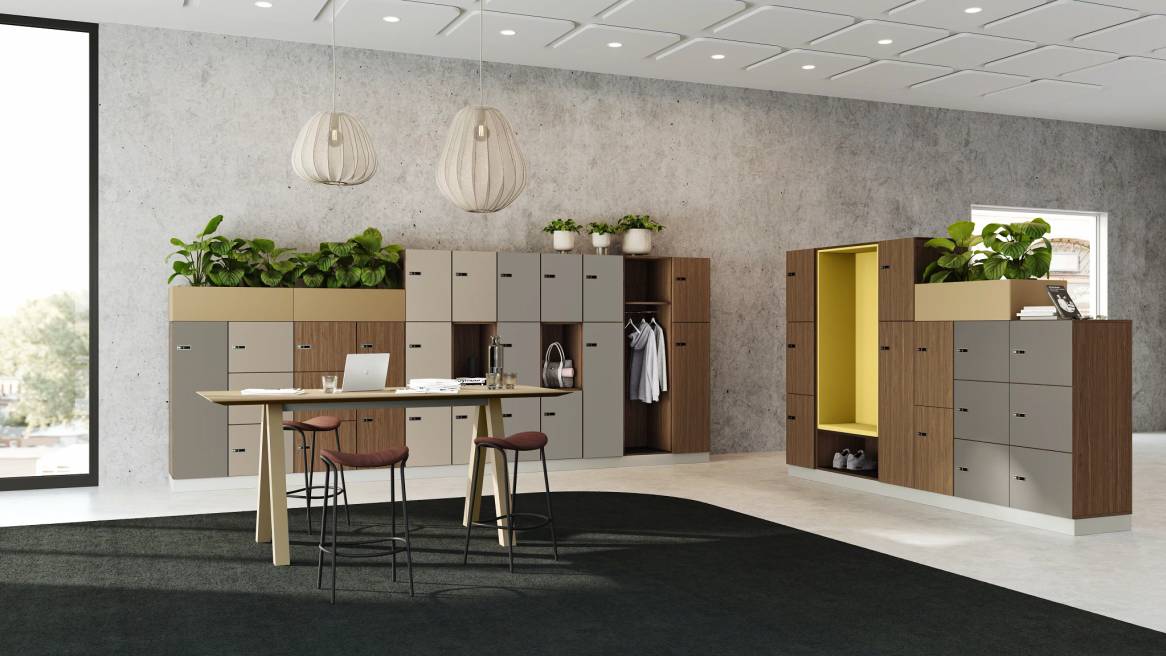Conversations: A Warm Welcome
An inside look at WorkValet, the new versatile locker solution designed to meet the needs of hybrid workers
As more and more workstations become shared – in the last year there has been a 15% drop in assigned spaces and leaders indicate the reduction will continue – the places where people start their workday in the office have become even more critical. New routines require organizations to create new ways to welcome people by giving them a way to comfortably transition into their workday, while also solving the pragmatic question of where to put their stuff. Work Better spoke with Viola Vallon, an industrial designer at Steelcase, to learn more about the process and design inspiration behind WorkValet and how it helps create a warm welcome for hybrid workers.
WB: Why design a new locker solution like WorkValet today?
VV: As hybrid work becomes the norm, people need different solutions for personal storage. Lockers were originally created to store files and papers – and compartment sizes were based on that. Today, people need space for a variety of items from laptops and water bottles to bike helmets and luggage. We also noticed a demand for different sized lockers in varied locations within the office.
That’s where it all started. We took on the challenge to create a new, adaptable locker system that supports what people need today. Every component is designed with functionality, aesthetics and adaptability in mind. All seemingly small elements are created to establish a sense of comfort and familiarity. Because at the end of the day, people are interacting closely with this product and trusting it to look after their things.
WB: Take us through the design process and how the team discovered what people need from lockers today.
VV: Research played a significant role in the design of WorkValet. We analyzed what people are bringing to the office, their work patterns, how often they use their lockers during the day, the kind of locks they like to use and how they book lockers. We also conducted interviews with facility managers, architects and designers. The goal was to gain a thorough understanding of what the people working in the space need as well as what facility and real estate professionals require.
We categorized the data into three types of employees, based on how often and when they are in the office – untethered, destination and anchored workers. Untethered workers are in the office a few days a week and tend to access their lockers at the start and end of the day. Destination workers come into the office for specific events or interactions and often travel from a distance. They need a locker close to the office entrance and large enough to store luggage. Finally, anchored workers are in the office the most and prefer a small, owned locker close to their workstation to access throughout the day.
From there, we designed applications — the boundary, bay and hub — based on where people prefer to access their lockers in the office.

WB: What new design features does WorkValet offer?
VV: Our research helped us define how different workers utilize lockers in today’s office. We made sure to include versatile features to fit individual work routines. Varying locker compartment sizes offer options for storing a wide variety of items.
Unique shelving options are intentionally designed to utilize locker space resourcefully. The shelves don’t use the full cross section of the locker, meaning people can place their belongings on a shelf while also being able to take advantage of all the space the locker offers. For example, a yoga mat can be stored using the full height of the locker, while shoes and laptops can be placed on shelves.

The colors, finishes, patterns and materials can be customized to fit the vibe of different office environments. The upholstered nook allows people to sit and gather their things or change their shoes. Planters can also be integrated into the locker system, which supports the connection to nature that’s so important for wellbeing.
WorkValet does more than store things – it ultimately contributes to an inviting office atmosphere with its versatility. All of these carefully designed elements work together to ensure people feel supported and comfortable as they journey through their day.
Viola Vallon, Industrial Designer, EMEA, Steelcase

Munich-based Industrial Designer Viola joined Steelcase in 2018. She was part of the product development team working as a design lead on research and design for the WorkValet product line.
Prior to Steelcase, Viola worked in design consulting and graduated with a Master’s degree in Fine Arts from Lund University and a Bachelor of Arts from Hochschule für Gestaltung Schwäbisch Gmünd.

